| Author |
Message |
Solarnewbie
Newbie

Joined: 30/10/2017
Location: United StatesPosts: 5 |
| Posted: 02:35am 14 Oct 2021 |
 Copy link to clipboard Copy link to clipboard |
 Print this post |
|
Built ATS using solid state relays SSRs. 4 SSRs in total 2 for the grid L1 & L2 and 2 for the inverter L1 & L2. House supply breaker is tied to both sets of SSRs. Arduino 2560 (my only nano wouldn't upload) does the switching thru an input from relay contacts powered by 220v from inverter. Code to follow later date.
Switching was smooth and uneventful, until, 10 minutes later the mosfets began blowing off like fireworks. As near as I can tell, the inverter being off grid only was somehow pushing against the grid possibly because of cheap SSRs missing zero cross circuit or because my code switched on the inverter SSR a ms before turning off the grid SSR. Perhaps the triacs were held open if caught in a half cycle? I'm not the greatest at coding and the is the first time I used a code where it mattered. Forgot delays in my code as well. New inverter is on the way and Ine of those Sunyima universal inverter boards to test out with the old inverters transformer coil and the SSR-ATS with new reliably sourced SSRs. Found a seller that when asked questions about features they seemed to be very knowledgeable which is surprising for the Philippines. Cost around $28usd each.
Will going back to a mechanical ATS for now. That may be permanent since I find absolutely nothing online or YouTube about anyone building a solid state ATS.
Any ideas would be appreciated
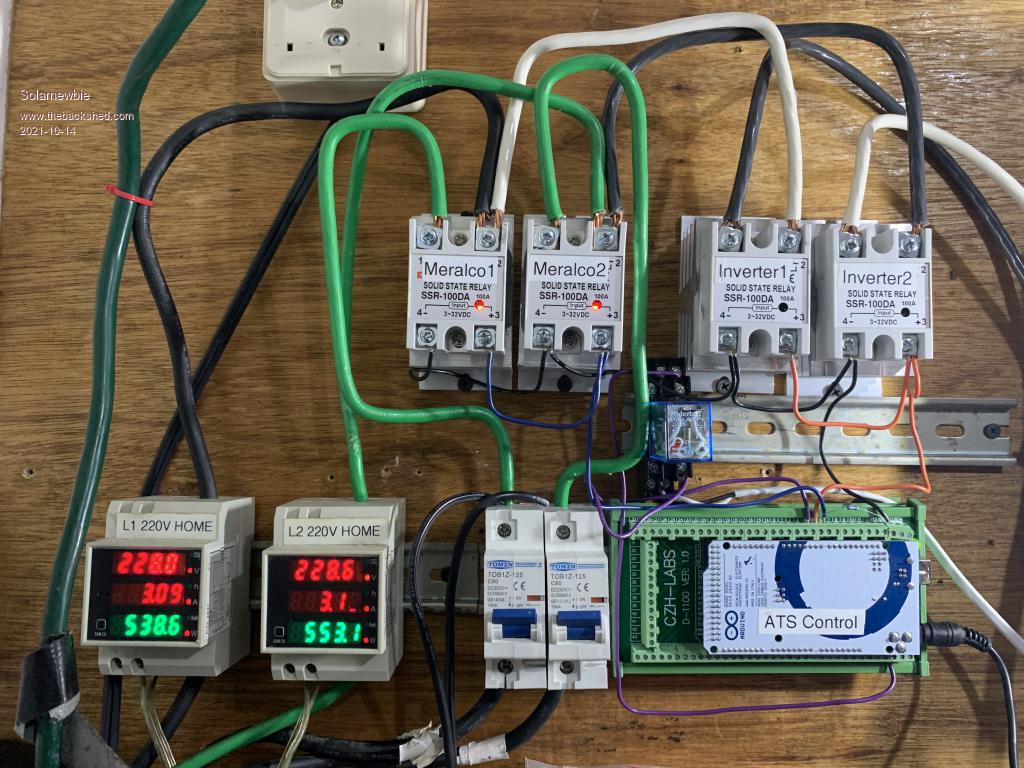
Edited 2021-10-14 12:42 by Solarnewbie |
| |
Davo99
Guru

Joined: 03/06/2019
Location: AustraliaPosts: 1578 |
| Posted: 08:16am 14 Oct 2021 |
 Copy link to clipboard Copy link to clipboard |
 Print this post |
|
My repeated experience of those SSR's is they are not worth wasting money on. The ultimate Chyneese over specification. If they were rated to 100 Amps you could be supremely Confident they would handle up to 10. 20 may be pushing it but if you like to live dangerously....
I just learnt to use regular MOSFETS and be done with it.
I bought some expensive SSR's ( Crydom I think they were called, black colour) but then never got round to using them so can't say if they are any more reliable.
Looks like will be a very useful project once you iron out the bugs or perhaps the unreliable components.  |
| |
Solar Mike
Guru

Joined: 08/02/2015
Location: New ZealandPosts: 1138 |
| Posted: 09:10am 14 Oct 2021 |
 Copy link to clipboard Copy link to clipboard |
 Print this post |
|
I think you are asking for continuing trouble by using SSR's in this application. Solid state devices often fail to a shorted condition and are inherently very unsafe and likely to blow up your equipment.
In a previous job I used to design and build similar devices for connecting diesel generators to the main switchboard, in all cases we used changeover relays driving main contactors both with interlocking contacts wired so if one relay was active the other could never pull in and vise versa; this is a requirement of the electrical regs both here in NZ and Aus.
If you want to use a cpu controller then the safest most reliable method would be to connect it to a pair of relay contactors wired as described.
Cheers
Mike |
| |
phil99

Guru

Joined: 11/02/2018
Location: AustraliaPosts: 2131 |
| Posted: 11:09am 14 Oct 2021 |
 Copy link to clipboard Copy link to clipboard |
 Print this post |
|
There is another requirement, the contactors must be both electrically and mechanically interlocked. Approved ATS contactors have a sliding bar that links the contactors. When one is energized the other can't move even if the electrical interlock fails.
If you really want to use SSRs anyway ensure the inverter tracks the mains frequency and phase to minimize the voltage difference and thus the risk of damage. A two cycle pause between one switching off and the other on would also help. |
| |
pd--
Senior Member

Joined: 11/12/2020
Location: AustraliaPosts: 122 |
| Posted: 11:37am 14 Oct 2021 |
 Copy link to clipboard Copy link to clipboard |
 Print this post |
|
+1 on the electrically and mechanically interlock.
had a set of main contacts weld themselves together but the aux contacts still opened when the coil de energised.
if it wasent for the mechanical interlock there would have been a big mess
SSR's for a ATS are a bad idea |
| |
Technophiliac

Regular Member

Joined: 18/12/2020
Location: New ZealandPosts: 92 |
| Posted: 02:20am 17 Oct 2021 |
 Copy link to clipboard Copy link to clipboard |
 Print this post |
|
{Various words roam my mind....} Moving on, whats an Interlock? https://www.etechnog.com/2021/04/contactor-interlocking-circuit-wiring.html seems to explain.
I've been looking at using a Chinese transfer switch which switches two SPDT relays as an ATS using the input voltage level to turn the relays on and off.
Its mains / load switching section looks like this:
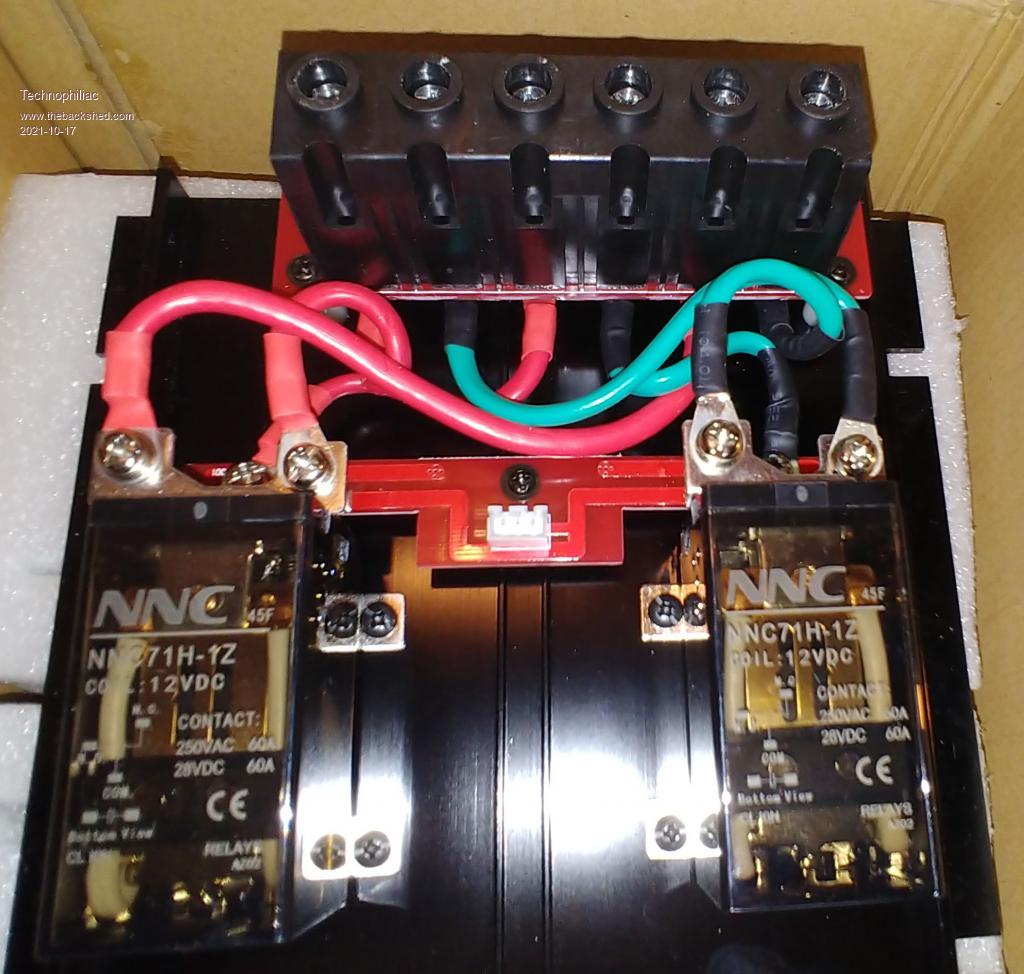
Seemed a good idea to use as an ATS. I had some feedback it was not a good idea as an approved device to use in Australasia but I could not get a reason.
I guess one reason is it has no interlock circuitry. (Maybe there are others too?) The voltage sensing section limits can be manually set and seem to work well turning the relays on and off (simultaneously - the coils seem to be wired in parallel.)
The relays are stated to switch 60A mains, and 60A @ 24V DC giving it wide use as a Mains ATS (including the dual phase US system) or an alternative ATS of DC sources for smaller inverters.
Can this device be revised to meet interlocking requirements e.g. changing the relays to 2 DPDT to separate the NO and NC contacts to create the interlock using readily available relays?
Also this device is wired to switch phase and neutral. Does neutral need to be switched, or is an interlocked phase switch sufficient (US dual phase excepted)?
Davo, Wellington. You can have it perfect, on time, and at the best price. Choose any two. |
| |
phil99

Guru

Joined: 11/02/2018
Location: AustraliaPosts: 2131 |
| Posted: 03:16am 17 Oct 2021 |
 Copy link to clipboard Copy link to clipboard |
 Print this post |
|
Re the neutral switching, my understanding is it is required unless the inverter is approved for direct connection by the local supply authority.
Re interlock, extra contacts in each relay can be wired in series with the coil of the other for an electrical interlock but I see no provision for a mechanical interlock. AS/NZS regulations require one. PD--'s post demonstrates the need for it. |
| |
Technophiliac

Regular Member

Joined: 18/12/2020
Location: New ZealandPosts: 92 |
| Posted: 07:40am 17 Oct 2021 |
 Copy link to clipboard Copy link to clipboard |
 Print this post |
|
How does one meet the mechanical requirement? I can find 4PDT relays but only up to around 10 amps @ 240V AC. But that uses one coil, so no cutting off the 2nd coil when the alternate situation is required. One run two pairs of contacts in series to reduce the contact fusing risk. But even a DPDT relay is mechanically connected and there seems to be no alternate coil risk there either. Correct me if I am wrong but if one contact welds shut the whole thing will be locked in that position? Without checking one I suppose a phase terminal could fuse, and the neutral contact might float in an intermediate position. Is that all that's required - a DPDT relay of sufficient capacity? How do the commercial units work?
Davo, Wellington. You can have it perfect, on time, and at the best price. Choose any two. |
| |
pd--
Senior Member

Joined: 11/12/2020
Location: AustraliaPosts: 122 |
| Posted: 08:12am 17 Oct 2021 |
 Copy link to clipboard Copy link to clipboard |
 Print this post |
|
There are many different designs, sum manufactures have a back plate that the relay/contactor's attaches to.
in the back plate there is a rod that slides sideways to block one or the other contactor from moving.
sum like the ABB video that follows use a connecting block between the two contactors.
https://www.youtube.com/watch?v=ZdxpVi6FMiI
industrial suppliers sell this type of stuff
instead of looking for relays look for contactors , they are the big brother to relays.
As an example you could use two of the following contactors mounted on the interlock base
https://www.tradezone.com.au/product/nhp-mechanical-interlock-for-ca8-32169.html
https://www.tradezone.com.au/product/nhp-4-pole-4kw-contactor-with-240-volt-ac-coil-32168.html |
| |
Solarnewbie
Newbie

Joined: 30/10/2017
Location: United StatesPosts: 5 |
| Posted: 06:40am 07 Nov 2021 |
 Copy link to clipboard Copy link to clipboard |
 Print this post |
|
I have since rewritten my code and added a delay between turning off one SSR and turning on the other. 25ms did the trick and electronics in the house don't react to the switch. 100ms then 50ms still reset everything but the modem. I'm told by another that 20ms would be the minimum.
I have since added a fan to the heat sinks since they seem quite warm. Also wired the grid and inverter supply right to left on the SSRs to be on the correct side of the cross cut circuit.
Bought a Sunyima 190a 48v inverter and connected it to my powerjack 30v toroid transformer. Inverter calls for a 26v xfmr so I had to raise output volts in settings to match the grid.
I believe I have overcome the problem with my ATS which was my poor coding skills. As far as ensuring keeping inverter and grid separate, code and the arduino do that task. Sure they can fry and short but contactors have been known to fuse together. I saw it frequently in the HVAC business. Grid tied inverter stay connected even if grid is missing so not sure what safety measures local and federal authorities require in that case to prevent back feed. Of course linemen take safety precautions and civilians should t be handling downed wires. |
| |
Solarnewbie
Newbie

Joined: 30/10/2017
Location: United StatesPosts: 5 |
| Posted: 06:40am 07 Nov 2021 |
 Copy link to clipboard Copy link to clipboard |
 Print this post |
|
I have since rewritten my code and added a delay between turning off one SSR and turning on the other. 25ms did the trick and electronics in the house don't react to the switch. 100ms then 50ms still reset everything but the modem. I'm told by another that 20ms would be the minimum.
I have since added a fan to the heat sinks since they seem quite warm. Also wired the grid and inverter supply right to left on the SSRs to be on the correct side of the cross cut circuit.
Bought a Sunyima 190a 48v inverter and connected it to my powerjack 30v toroid transformer. Inverter calls for a 26v xfmr so I had to raise output volts in settings to match the grid.
I believe I have overcome the problem with my ATS which was my poor coding skills. As far as ensuring keeping inverter and grid separate, code and the arduino do that task. Sure they can fry and short but contactors have been known to fuse together. I saw it frequently in the HVAC business. Grid tied inverter stay connected even if grid is missing so not sure what safety measures local and federal authorities require in that case to prevent back feed. Of course linemen take safety precautions and civilians should t be handling downed wires. |
| |
Solarnewbie
Newbie

Joined: 30/10/2017
Location: United StatesPosts: 5 |
| Posted: 06:43am 07 Nov 2021 |
 Copy link to clipboard Copy link to clipboard |
 Print this post |
|
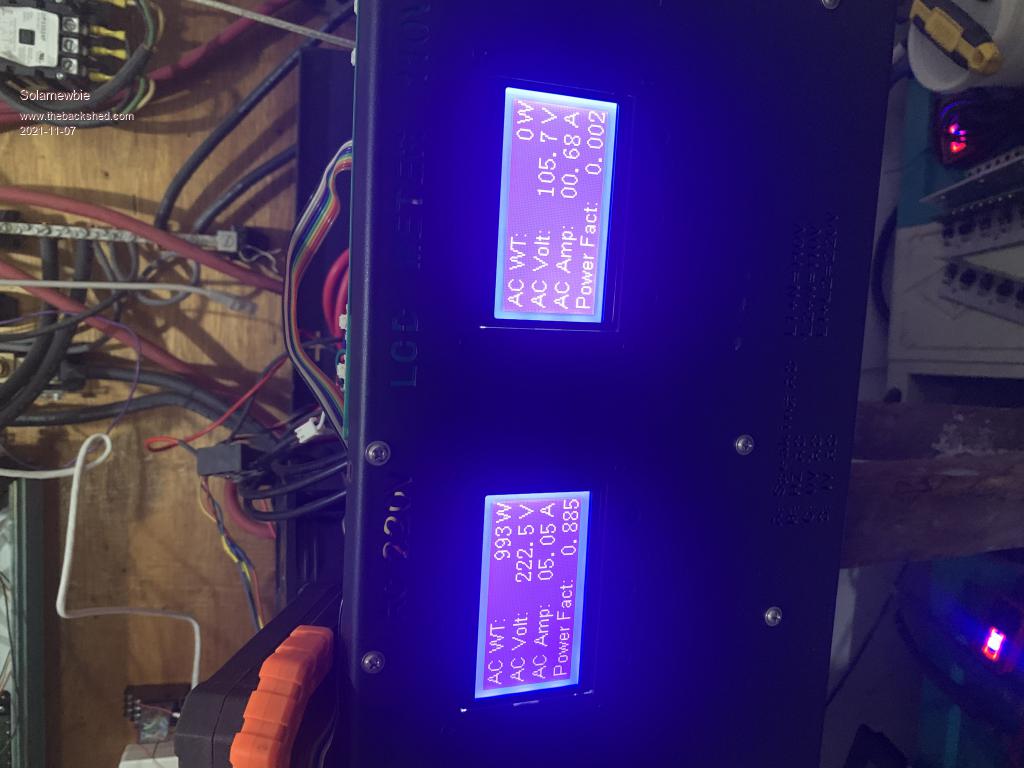
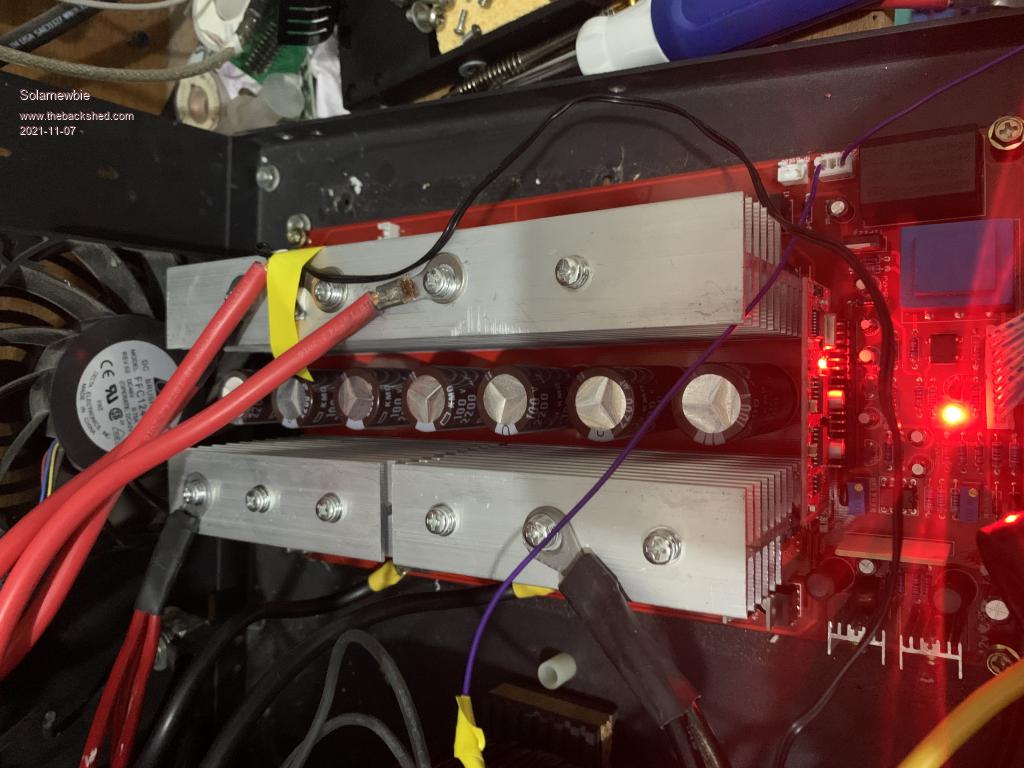
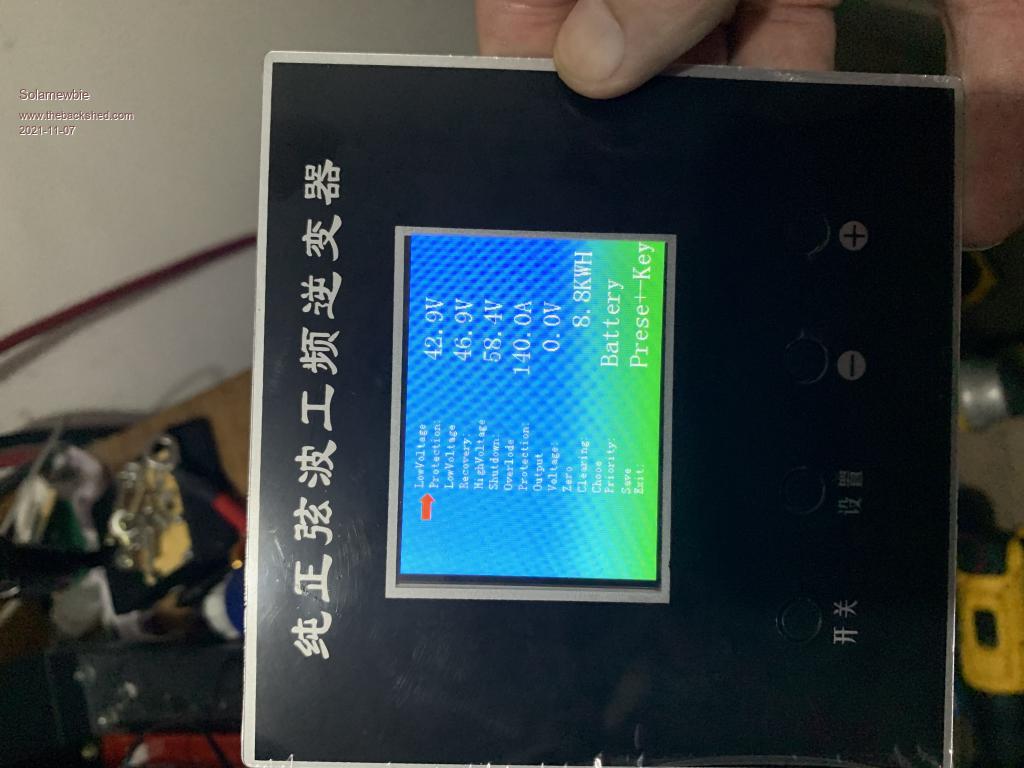 |
| |
Solarnewbie
Newbie

Joined: 30/10/2017
Location: United StatesPosts: 5 |
| Posted: 06:47am 07 Nov 2021 |
 Copy link to clipboard Copy link to clipboard |
 Print this post |
|


 |
| |
Godoh
Guru

Joined: 26/09/2020
Location: AustraliaPosts: 455 |
| Posted: 07:55am 07 Nov 2021 |
 Copy link to clipboard Copy link to clipboard |
 Print this post |
|
Hi Solar newbee. Just a quick glance at the board and it looks like the holes in the lugs you used are a bit big for the screws that hold them to the heatsink. Remember that you are talking about serious current at times going through those wires.
My PowerJack 8kw blew up because of a bad connection, It was just another example of bad quality control from the factory.
I suggest that you get some flat washers that fit those screws and are large enough to give plenty of surface area for connection the the lugs.
I also just received a 5kw board, ( not a Sunyima but similar), I had trouble getting the output voltage high enough with the adjustment and ended up taking two turns off the primary winding of the transformer.
It works great and is very quiet. My system is 24 volt and the no load current is only 0.8 amps which I am happy with, that is a lot less than the powerjack.
Have fun
Pete |
| |

